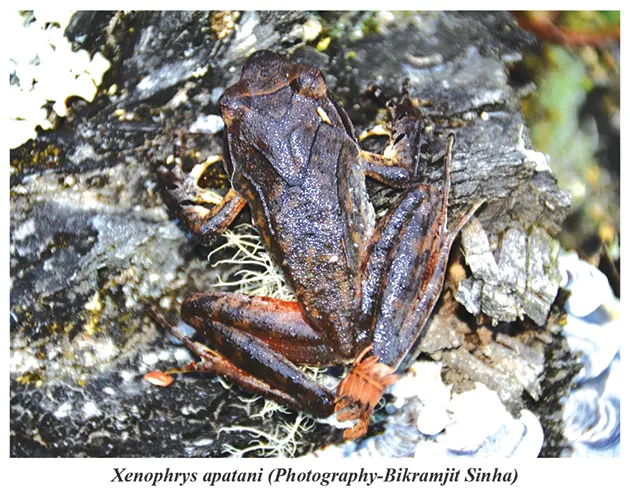ITANAGAR, 2 Jul: In a major discovery, scientists from the Zoological Survey of India (ZSI) have identified a new species of horned frog, named Xenophrys apatani, in the Tale Wildlife Sanctuary (WLS) in Lower Subansiri district, a key area within the eastern Himalaya biodiversity hotspot.
Led by Bhaskar Saikia and Bikramjit Sinha of ZSI Shillong (Meghalaya), alongside their colleagues KP Dinesh and A Shabnam from ZSI Pune (Maharashtra), and Ilona Jacinta Kharkongkar from ZSI Itanagar, the team’s study overturns a previous erroneous report of the Maoson horned-frog (Xenophrys maosonensis) in Arunachal Pradesh. Notably, in 2019, Saikia and his team had mistakenly identified the specimen now named Xenophrys apatani as Xenophrys maosonensisdue to limited genetic data.
“Upon closer examination and a comprehensive phylogenetic analysis involving 142 molecular sequence data, we found significant genetic and morphological differences between the specimen from Arunachal Pradesh and the true Xenophrysmaosonensis,” explained Saikia, who is an alumnus of the government higher secondary school Doimukh.
The research team employed a combination of genetic data from mitochondrial 16S rRNA and detailed morphological examinations to determine that the frog previously thought to be Xenophrys maosonensisfrom Tale WLS is actually a distinct species. “Named Xenophrys apatani, in honour of the Apatani tribe, known for their conservation efforts of wild flora and fauna, the new species exhibits unique genetic and physical characteristics,” Saikia said.
“Our findings highlight the importance of rigorous taxonomy and the use of integrative approaches in species identification,” said Dr Bikramjit Sinha, who was the then in-charge of ZSI Itanagar, and had led the field survey team that made the collection of this species from the Tale WLS.
“This discovery not only expands our understanding of frog diversity in Northeast India but also underscores the need for accurate species delineation in biodiversity research,” Saikia added.
Tale WLS is noted for its rich biodiversity, including diverse amphibian species. The discovery of Xenophrys apatani underscores the sanctuary’s significance as a hotspot for amphibian conservation in the eastern Himalayas. Incidentally, this is the fifth new species of frogs discovered by Saikia and Bikramjit Sinha in recent times from Tale WLS. In 2017, they had made the discovery of Odorrana arunachalensis, and in 2019 they had discovered three new species of Liurana frogs, and named them Liurana himalayana, Liurana indica and Liurana minuta from this protected area.
Besides Tale, Saikia and Sinha and their colleagues from ZSI Pune had previously collaborated in 2022to discover three new species of cascade frogs from western Arunachal. These were Amolops terraorchisand Amolops chanakya from Sessa and Dirang, respectively, in West Kameng district, and Amolops tawang from Jang-Mukto road in Tawang district.
“The current research finding is published in the latest issue of the Records of the Zoological Survey of India journal, contributing significantly to the ongoing efforts to catalogue and protect India’s unique biodiversity,” said Saikia.




